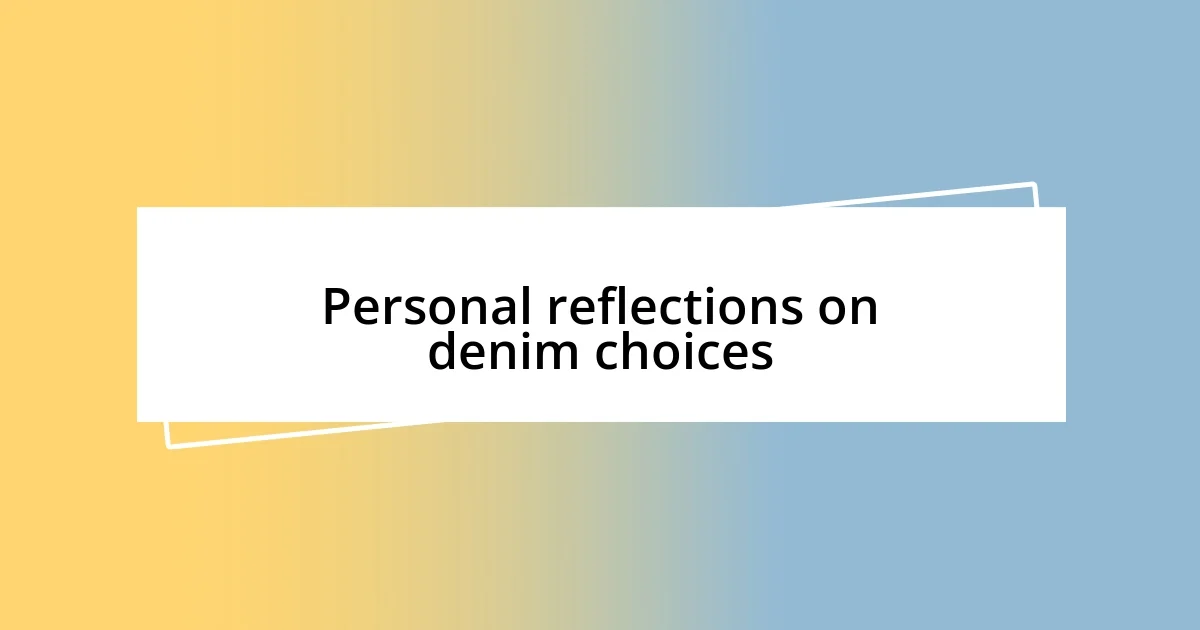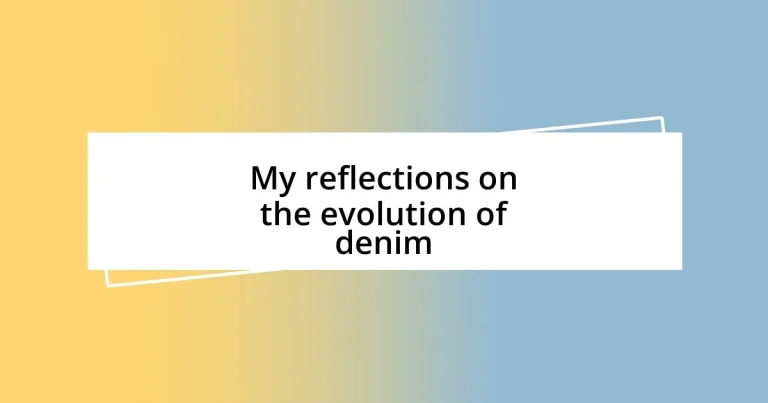Key takeaways:
- Denim originated in France in the late 17th century and evolved from a durable work fabric into a cultural icon, especially during the American Gold Rush and the counterculture movements of the 1950s and 1960s.
- Key styles of denim have emerged through the decades, reflecting societal changes, from high-waisted styles in the 1920s to grunge aesthetics in the 1990s, each resonating with specific cultural sentiments.
- Recent trends focus on sustainability and innovation, including eco-friendly production methods, recycling initiatives, and the future potential of smart textiles and customizable designs in denim fashion.

History of denim fabric
Denim fabric traces its roots back to the late 17th century in France, where a sturdy cotton twill was developed in the city of Nîmes, giving rise to the term “serge de Nîmes,” or denim. I often wonder how such a rugged fabric could evolve into a wardrobe staple that spans cultures and generations. It’s fascinating when you realize that what began as a work fabric for laborers would eventually adorn the likes of Hollywood stars and fashion icons.
In the 19th century, denim took on a transformative role during the American Gold Rush, becoming the fabric of choice for miners and workers alike. The introduction of rivets by Levi Strauss in the 1870s made jeans even more durable, providing a functionality that appealed to the hard-working class. I can almost picture the rough hands of those miners, each wearing their jeans as a badge of honor, a testament to their challenging lifestyle.
As the decades rolled on, denim became more than just practical attire; it morphed into a fashion statement in the 1950s and ’60s, symbolizing rebellion and youth culture. I remember my first pair of vintage denim jeans—each frayed edge and faded spot told a story. Have you ever felt that rush of nostalgia while wearing a piece of clothing that connects you to a larger history? Denim, with its rich past, allows us to not only wear fabric but also carry stories of resilience and creativity.

Key styles through the decades
The evolution of denim across decades reflects societal changes and cultural milestones. I often find myself reminiscing about the iconic bell-bottoms of the 1970s—those jeans were more than just a trend. They represented freedom and a break from convention, often making me feel like I could conquer the world. Each decade has introduced unique styles that resonate with particular moments in time.
Here’s a glimpse of key denim styles that defined different eras:
- 1920s: High-waisted and wide-leg styles emerged, often worn by women entering the workforce.
- 1950s: The classic ‘dad jeans’ and tight-fitting designs became popular, symbolizing teenage rebellion, thanks to stars like James Dean.
- 1960s: Tie-dye and flared jeans became fashion staples, embodying the counterculture movement.
- 1970s: This era saw the rise of the bell-bottoms, associated with a sense of freedom, particularly in music and art scenes.
- 1980s: Acid-wash jeans took center stage, a nod to the bold and flashy aesthetic of pop culture.
- 1990s: Grunge style emerged, with baggier fits and distressed looks reflecting a shift towards a more laid-back attitude.
Reflecting on these styles, I can’t help but appreciate not just the fabric, but the sentiments they evoke—the confidence of wearing a bold silhouette or the comfort of a worn-in pair.

Cultural impact of denim
The cultural impact of denim is profound and multifaceted. I often think about how denim transcends socioeconomic boundaries, appealing to both high fashion and everyday wear. It’s incredible to observe the fabric evolve into a canvas for self-expression, with trends emerging from pop culture, art, and even activism. For instance, during the anti-establishment movements of the 1960s, I remember seeing denim jackets adorned with patches and slogans—the fabric became a symbol of protest and unity. When I wear my favorite patched-up jacket, it feels like I’m not just sporting a piece of clothing but also joining a conversation that spans decades.
Denim’s presence in the entertainment industry further amplifies its cultural significance. I recall the excitement when I first saw my favorite musician on stage in a classic pair of ripped jeans—it made me feel connected to a sense of rebellion and creativity that the genre symbolized. From James Dean to modern-day artists, celebrities have leveraged denim to craft powerful images. Just think about the impact of denim on high fashion; it’s fascinating how runways once dominated by formal looks have embraced this casual fabric, elevating its status.
Here’s a comparison of how denim has impacted various cultural aspects over the years:
| Era | Cultural Context |
|---|---|
| 1950s | Teen rebellion; denim represented defiance against societal expectations. |
| 1960s | Counterculture movement; jeans became symbols of freedom and political activism. |
| 1970s | Fashion statement; bell-bottoms and colorful denim reflected liberation in both music and art. |
| 1980s | Introduction of acid-wash; boldness in expression through a flashy new aesthetic. |
| 1990s | Grunge movement; denim signified a laid-back, anti-fashion attitude. |
Examining denim’s cultural journey reveals not just trends but the emotions and sentiments tied to each era. It’s an authentic reflection of who we are and what we cherish, making denim an integral part of our collective narrative.

Innovations in denim technology
Denim technology has come a long way, introducing innovations that have transformed this beloved fabric. One noteworthy advancement is the development of stretch denim, which I first encountered when I tried on my first pair of jeggings. The blend of elastane with cotton not only made jeans more comfortable but also allowed for a flattering fit that moved with my body. Can you remember the first time you experienced that kind of flexibility in denim? It felt liberating, combining style and comfort like never before.
Another fascinating innovation is the eco-friendly processes now being adopted by denim manufacturers. I vividly remember the first time I heard about waterless dyeing techniques that use up to 90% less water than traditional methods. This shift towards sustainability resonated deeply with me, as it aligns with my values of preserving our planet. It made me feel good to know that I could enjoy my favorite jeans without compromising my commitment to environmental responsibility.
Lastly, the rise of digital printing technology has opened up a world of design possibilities. I was amazed the first time I saw a pair of jeans with intricate, personalized patterns created through digital fabric printing. This technology allows for unique designs that express individuality, which is something I cherish in fashion. It got me thinking—how does your wardrobe reflect your personality? With innovations like these, denim isn’t just fabric; it’s a canvas for creativity and self-expression.

Sustainable denim practices
Sustainable denim practices have made significant strides recently, and I can’t help but feel excited about the changes I’m witnessing in the industry. For instance, I remember when I stumbled upon a brand that uses organic cotton and environmentally friendly production methods. It was eye-opening to think that my choices could promote eco-friendliness while keeping me stylish. Isn’t it gratifying to wear something that not only looks good but also does good for the planet?
Another compelling aspect of sustainable denim is the rise of recycling initiatives. I often feel proud when I donate my old jeans to programs that repurpose them into insulation for homes or even new denim products. It makes me reflect on the life cycle of my clothing. How much extra life can a well-loved pair of jeans have if we just shift our perspective on waste? Instead of ending up in landfills, they can have a second chance, embracing sustainability with every new transformation.
There’s also a growing trend toward transparent supply chains. I recall my surprise when a local boutique shared the stories behind the brands they carried and how they sourced their materials. Learning about fair labor practices and eco-conscious efforts deepened my appreciation for the garments I wear. Have you ever looked at a label and felt a connection to the artisans behind the scenes? It’s a small act, but it fosters a more meaningful relationship with my clothing—one that resonates with my values and promotes a brighter future for denim.

Future trends in denim
Denim’s future is undoubtedly intertwined with technology, and I find myself particularly intrigued by the potential of smart textiles. Imagine wearing jeans that can monitor your body temperature or even track your fitness levels! I remember the first time I tried on a piece of clothing with built-in tech, and it felt like stepping into a sci-fi movie. This trend could redefine the way we interact with our clothing—don’t you think that merging fashion and functionality could elevate our daily lives?
Another exciting future trend is the emergence of customizable denim. It’s fascinating to think about how we might soon be able to design our own jeans online, selecting not just size and fit but also colors and transformative features like removable patches or adjustable lengths. I vividly recall how a favorite pair of jeans once went unworn because they didn’t quite fit anymore—I had wished for a quick fix. How empowering will it be when we can create our denim tailored just for us, allowing our personalities to shine through every detail?
Lastly, I believe we’ll see an even stronger focus on circular fashion within the denim industry. The idea of leasing jeans, rather than buying them outright, captivates me. I once participated in a clothing swap, and it felt refreshing to refresh my wardrobe without the guilt of overconsumption. Wouldn’t it be incredible if we could wear high-quality, stylish denim for a season and then return it for something new? This not only encourages sustainability but also fosters a community around shared fashion experiences.

Personal reflections on denim choices
Reflecting on my denim choices, I find that each pair tells a story. I still remember the thrill of purchasing my first high-waisted jeans—it felt like a bold statement. How often do we wear denim that mirrors our evolving identities? For me, those jeans became a symbol of confidence and self-expression during a time of personal growth.
One choice that stands out in my journey is embracing vintage denim. The moment I walked into a thrift store and discovered a perfectly worn-in jacket, I felt a wave of nostalgia and connection to its past. I often wonder about the adventures it has had before arriving in my closet. Each scuff and fray adds character, reminding me that fashion can be both unique and sustainable.
I’ve also experimented with different fits over the years, from skinny to boyfriend to wide-leg styles. It’s interesting how the fabric has reflected my changing lifestyle—my favorite flared jeans feel like a nod to a carefree, bohemian phase. Doesn’t it make you think about how our preferences evolve with our lives? The denim I choose not only suits my aesthetic but also aligns with my journey, making it more than just clothing; it’s part of who I am.












